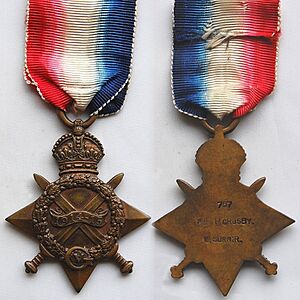1914–15 Star facts for kids
Quick facts for kids 1914–15 Star |
|
|---|---|
 |
|
| Presented by | the Monarch of the United Kingdom and the British Dominions, and Emperor of India |
| Country | |
The 1914–15 Star is a special medal from the British Empire. It was given to soldiers and officers from Britain and its colonies. They earned it for serving in the First World War during 1914 and 1915. This medal was always given along with two other medals: the British War Medal and the Victory Medal.
Contents
What is the 1914–15 Star?
This medal was created in December 1918. It honored those who fought against the Central European Powers (like Germany and Austria-Hungary) in any war zone. To get this medal, soldiers had to serve between August 5, 1914, and December 31, 1915. However, if they had already received the 1914 Star, they could not get this one.
The idea for this medal came about because many soldiers from Australia and New Zealand fought bravely. They served in places like Gallipoli. These countries wanted their soldiers to be recognized, just like the first British soldiers in France. This led to the creation of the 1914–15 Star. It made sure more soldiers from different parts of the British Empire were honored.
Who Received the Medal?
About 2,366,000 of these medals were given out. They went to soldiers, sailors, and other support staff. This included people from Britain, its Dominions (like Canada and Australia), India, and other colonies.
- About 283,500 medals went to the Royal Navy.
- About 71,150 medals went to Canadians.
Like the 1914 Star, the 1914–15 Star was never given alone. People who received it also got the British War Medal and the Victory Medal. These three medals were sometimes jokingly called Pip, Squeak and Wilfred. These were popular cartoon characters: a dog, a penguin, and a rabbit. Pip was either of the two Stars, Squeak was the British War Medal, and Wilfred was the Victory Medal.
What Does the Medal Look Like?
The 1914–15 Star looks like a four-pointed star made of shiny bronze. It has a crown at the top. The medal is about 50 millimeters tall and 44 millimeters wide.
Front of the Medal
The front of the medal shows two crossed swords pointing upwards. These swords are covered by a wreath of oak leaves. At the bottom of the wreath is the Royal Cypher of King George V. In the middle, there is a scroll that says "1914–15".
Back of the Medal
The back of the medal is plain. It has the recipient's service number, rank, and name carved into it.
The Ribbon
The ribbon for the medal is 32 millimeters wide. It has shaded and wavy bands of red, white, and blue. These are the colors of the United Kingdom's flag. The same ribbon was used for the 1914 Star.
How Medals Were Worn
Medals from the First World War were worn in a specific order:
- The 1914 Star.
- The 1914–15 Star.
- The British War Medal.
- The Mercantile Marine War Medal.
- The Victory Medal (United Kingdom).
- The Territorial War Medal.
South Africa's Medal Order
In South Africa, a new system for military medals was started in 1952. New South African awards were worn before older British medals. The only exception was the Victoria Cross, which always came first. For campaign medals given to South Africans, the 1914–15 Star was worn as shown below.
- It was worn after the Natal Native Rebellion Medal.
- It was worn before the British War Medal.
Images for kids




